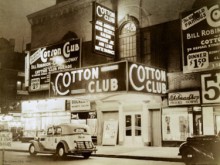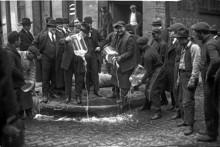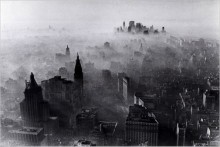The Great Gatsby
 Francis Scott Fitzgerald's novel The Great Gatsby was originally published in 1925.
Francis Scott Fitzgerald's novel The Great Gatsby was originally published in 1925.
The novel has been adapted to film numerous times. The latest is Baz Lurhmann's 2013 adaptation.
Due to Danish copyright laws, the book is in the public domain and free for download. Links in the blue box on the right. Please note that there is also a pdf-glossary.
While reading the book, please answer these comprehension questions.
Tasks for the book:
Chapter 1:
Group 1: Characterise Daisy. Use words from the text and add your own.
Group 2: Make a drawing of Tom. Describe him in your own words.
Group 3: Describe Tom and Daisy's house in your own words. Find a few photos as illustrations.
Group 4: Write a conversation between Tom and Daisy. It takes place right after Nick has left and Jordan has gone to bed.
Group 5: Imagine that Nick, upon returning from Tom and Daisy's house, writes an unsent letter giving Daisy some advice. Write that letter.
Chapter 2:
Group 1: Find words used in the text to describe the Valley of Ashes. What was the Valley of Ashes in reality? What do you associate with ashes and what do you think the Valley of Ashes symbolises in the novel?
Group 2: Examine chapter 2 (and chapter 1, if you have the time). Find everything in the text of the colour yellow. What do you think the colour yellow symbolises in the novel?
Group 3: Find examples from the text of how Nick's drinking is portrayed. How does he describe it himself? Can you see from the writing/narration that he is drunk?
Group 4: Make the storyboard for a whiskey TV commercial that uses (part of) this chapter as a means of selling alcohol.
Group 5: Make an anti-drinking campaign that uses (part of) this chapter as an argument not to drink.
Chapter 3:
Group 1: Characterise Gatsby, his smile and his behaviour. Use examples from the text. Try to imagine how he feels at his own party. Use quotations from the text to substantiate your interpretation. Present your topic on a wall using padlet.com. Share the wall with me.
Group 2: Characterise Jordan Baker. Give examples from the text. Present your topic on a wall using padlet.com. Share the wall with me.
Group 3: "I like large parties. They're so intimate. At small parties there isn't any privacy." Look up the word "paradox". In your own words, explain what a paradox is and discuss if Jordan's statement above is a paradox. Find arguments that support her statement - and arguments against it. Present your topic on a wall using padlet.com. Share the wall with me. Your wall should contain a few illustrations.
Group 4: Make a schedule for Gatsby's party. What happens at 7 PM? At 9? At 1 AM? etc. Find information in the text and find illustrations and photos online. Present your topic on a wall using padlet.com. Share the wall with me. Your wall should contain a few illustrations.
Group 5: The man in the library, "Owl Eyes", who ends up in a drunk driving scene at the end of the chapter: write his story. Use your imagination. Who is he? What does he do for a living? What has he been doing for the past week? How did he end up at Gatsby's? Why is he so impressed with his findings in the library? Etc. Write your story in a document and share it with me.
Chapter 4:
Today, you will work individually with one of five tasks. You choose what you wish to do.
1. Go into chapter 4 and find every word and phrase describing New York City. Find some photos that illustrate the impression of N. Y. C. Make a collage of what you find. You may use padlet.com if you wish.
2. Write a love poem based (more or less loosely) on the chapter. It can not contain names (Gatsby, Daisy etc.) and rhymes are forbidden. Choose one of these two titles:
- "What we do for love"
- "Drunk on her wedding day"
3. Write a letter from Gatsby to Nick in which you relate the story of how you met Daisy.
4. Write an entry in Daisy's diary about meeting Gatsby in 1917.
5. Write an entry in Daisy's diary about Tom. Imagine these are the early days of your marriage. Explain why you always say "Where's Tom gone?"
Chapter 5:
Group 1: Make a presentation about the theme "reality and dream" as it is expressed in chapter 5. Give examples from the text. What is Fitzgerald showing us?
Group 2: Find symbols in chapter 5. Look up the term "pathetic fallacy". Explain what it is and relate it to this chapter.
Group 3: Look up the term "farce". Write a farce re-enacting a scene or situation from chapter 5. Your farce should last at least a couple of minutes. Perform your farce to the rest of us.
Group 4: Find information about Coney Island (where Gatsby wants to take Nick) in the 1920s. Make a presentation with information and illustrations.
Group 5: Characterise the relationship between Gatsby and Daisy in chapter 5. Find examples from the text and try to understand and explain their reactions, behaviour and motives.
Chapter 6:
A) Five groups work on each their task. Each group must prepare a document with notes.
B) Presentations in matrix groups. Present your work in as much detail as time allows - and allow for questions.
C) In your matrix groups, discuss in how many ways the word "meretricious" applies to the plot and characters in The Great Gatsby. Look the word up on dictionary.com
D) In class, we will watch this video.
Chapter 7:
We are going to watch 30 minutes (1:25 - 1:54) of the Luhrmann film to examine how this chapter is interpreted in the movie.
Group 1: Look for the way the weather is presented in the film and the book. Also look for colour symbolism.
Group 2: Characterise Daisy in this chapter. (Film and book) Discuss why Luhrmann added an almost-fight.
Group 3: Characterise Tom in this chapter. Explain how and what he is feeling. (Film and book)
Group 4: Look for themes in the film and book. Some themes could be: death and sickness, values, carelessness, love and hate, anger and jealousy.
Chapter 8:
We are going to use GoAnimate to create videos depicting scenes from the chapter. Each group must create their scene, write the dialogue and make a short film using the tools provided. Your scene must contain dialogue.
Watch the video tutorial.
Group 1: Gatsby tells Nick about meeting Daisy. "She was the first 'nice' girl..."
Group:2: Gatsby takes Daisy "under false pretences".
Group 3: Gatsby reads the letter from Daisy. "The letter reached Gatsby while he was still at Oxford."
Group 4: Gatsby searches for Daisy. "He came back from France..."
Group 5: Wilson talks to Michaelis about the yellow car. "About three o'clock the quality of..."
Group 6: George and Myrtle Wilson talk about the dog leash. "I found it yesterday afternoon. She tried to tell me about it..."
Group: 7: Wilson searches for the owner of the yellow car. "His movements - he was on foot all the time..."
Chapter 9 (and 8):
13 of you will work with quotes and questions in class. The rest will work in three groups.
Get the tasks here.
Summing up:
1. In continuation of our class about the ending of the book, we will watch this video and listen to John Green's interpretation of Gatsby's greatness.
2. Plenum: main points - mindmap
3. Read this text by Fitzgerald while answering the comprehension questions in this document.
This text is homework for next class.
NB! There is a glossary on the final page.
.jpg)



.jpg)
.jpg)


.jpg)
.jpg)
.jpg)